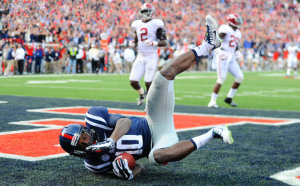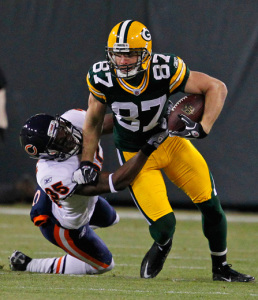Ole Miss had lost 10 straight games to Alabama, with 9 of those games coming by at least 22 points. The last three years, the Crimson Tide had won by an average of 36.7 points. Last year, a 3-0 Ole Miss team — fresh off of a blowout win in Texas — lost in Tuscaloosa, 25-0. So while the Rebels entered Saturday with a 4-0 record and a top-15 ranking, it would be fair to wonder how they would handle an Alabama team that was still Alabama.
Early on, the Tide looked like the better team. Amari Cooper was not dominating, but T.J. Yeldon looked great, en route to a 100-yard day. Quarterback Blake Sims looked smart and efficient, while Ole Miss couldn’t seem to get much going on offense like just about every opponent ever against Alabama. Still, the Rebels defense had played well enough to keep the Tide to just seven first half points, and the game looked to be 7-3 at the end of the half. That is, until what appeared to be the turning point of the game.
In the final seconds of the half, a screen pass to I’Tavius Mathers looked to be uneventful, until Cyrus Jones pulled off the trifecta — strip, fumble recovery, return for a touchdown. Replays showed that Jones committed a blatant facemask penalty, which likely lead to the fumble, but the refs didn’t see it. So after a great first half, a bad call meant Ole Miss was suddenly down 14-3. This seemed like a recipe for yet another Alabama win over the Upstart Of the Week.
But the weirdest thing happened in the second half. Ole Miss didn’t just outscore Alabama, it outplayed them. And not by an insignificant margin. Bo Wallace, Laquon Treadwell, and Evan Engram (other than a huge drop) were dominant in the second half, while the Ole Miss defense continued its excellent play. A gorgeous touchdown to Jaylen Walton gave Ole Miss a touchdown lead, but in typical Ole Miss fashion, the team botched the extra point not once, but twice. [1]First, the kick clanked off the upright. A roughing the kicker penalty gave the Rebels another chance, but the second extra point attempt was blocked.
With Ole Miss now clinging to only a 6-point lead, you could hardly blame anyone for expecting Alabama to win the game with a last second touchdown. A 30-yard catch and run by Cooper on the final drive put the Tide in inside the Ole Miss 30. But an incredible interception by Senquez Golson sealed the victory, and the day was complete: Mississippi not only beat, but outplayed Alabama, in a crucial game in a battle for SEC West supremacy. The game (and the aftermath) was everything that was great about college football.
Which almost makes it seem silly to transition to college football ratings, since we are still too early in the year for these ratings to hold significant meaning. Last week, I unveiled the initial SRS ratings. In perhaps two weeks, the ratings will start to really hold up, but for now, these are mostly a gut check. As always thanks to Dr. Peter R. Wolfe for providing the weekly game logs. As a reminder, these ratings are intended to be predictive only, and not intended as a way to rank college football teams for any other purpose. [continue reading…]
References
| ↑1 | First, the kick clanked off the upright. A roughing the kicker penalty gave the Rebels another chance, but the second extra point attempt was blocked. |
|---|


